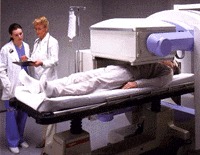Like all medical imaging examinations and therapy sessions, nuclear medicine imaging and therapy requires a team effort. The nuclear medicine patient care team is headed by a nuclear medicine physician. Other team members include nuclear medicine technologists and physicists. Each of these professionals has an important set of responsibilities, described below.

The nuclear medicine physician and technologist discuss the patient's study
The Nuclear Medicine Physician is a board-certified specialist. After obtaining his or her medical doctorate (MD) or doctor of osteopathy (DO) degree, these physicians have additional special training making them eligible for examination by the American Board of Nuclear Medicine or the American Board of Radiology. This training includes special instruction in the safe handling, storage and administration of radiopharmaceuticals (radionuclides). The nuclear medicine physician interprets the study and sends a report to the referring physician.
The Nuclear Medicine Technologist is specially trained to operate the sophisticated systems and computers used for diagnosis in nuclear medicine. Typically, technologists have had two or more years of training in nuclear medicine and are certified by the Nuclear Medicine Technology Certification Board (NMTCB) or the American Registry of Radiologic Technologists (ARRT-NM). The nuclear medicine technologist performs the patient examination under the supervision of the nuclear medicine physician.
Nuclear Medicine Scientists have advanced degrees in physics, pharmacy, and/or chemistry and assist the team by creating new computer programs for clinical use and diagnostic interpretation, assuring the quality of the radionuclides and systems used for patient care, and developing new applications for nuclear medicine.
Updated: June 10, 2008



